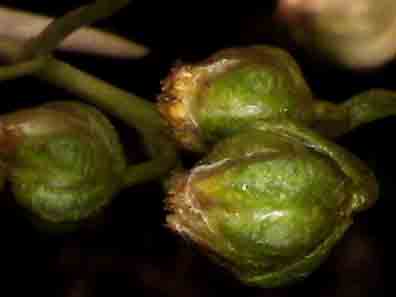
Location
On path #9 and in field before church on right (N35D33'02.591 X W105D41'23.238)
Flowers first observed: 9/5/17
Plant w/Flowers
 |
 |
The Flowers 50X

Distribution
"Tarragon is a widely distributed species with a range that extends east from southern Alaska to Manitoba and south to northern Mexico [2,41,45,52,58,79]. Its distribution also includes Eurasia, with common occurrences in central Asia and Siberia [45]. A distributional map of tarragon can be accessed through Plants database." (US Forest Service)
"Found on dry slopes and along arroyos, from 3,500-9,000 ft (1067-2743 m); flowers August-October. Distribution: Eurasia and much of western N. America; south to C. America." (SEINet)
Description
"Tarragon is a woody, native perennial shrub with stem heights ranging from 15.7 to 59.1 inches (40-150 cm). Aerial stems arise from thick, horizontal rhizomes growing in clusters and singly. Leaves are alternate, 0.5 to 3.1 inches long (1.2-8.0 cm), and 0.04 to 0.24 inch (1-6 mm) wide. Basal leaves are cleft with 1 to 3 lobes. The inflorescence is a panicle with numerous flowers. Outer florets are pistillate and fertile, central flowers are sterile, and ovaries are abortive. The seeds are achenes. Seed size is approximately 0.06 inch (1.5 mm) in length.
Tarragon supports large numbers of adventitious roots containing interxylary cork (formed within xylem tissue), offering the plant protection in xeric habitats [89]. One individual in Los Alamos, New Mexico was found to have a rooting depth of 83.9 inches (213 cm) [38]. Tarragon forms associations with vesicular-arbuscular mycorrhizae [96]." (US Forest Service)
"Perennial herb or subshrub, 50-120 cm tall, from rhizomes and coarse caudices, strongly tarragon-scented to unscented; stems numerous, erect to ascending, green to reddish brown, markedly striate. Leaves: Alternate, sessile; blades gray-green and sparsely hairy or bright green and glabrous; lowermost leaves 3-cleft into lance-linear divisions 1-5 cm long; upper leaves linear to oblong, tapering to base, 1-7 cm long by 1-5 mm wide, mostly entire, sometimes irregularly lobed, acute. Flowers: Flowering heads disciform, often nodding, arranged in dense, leafy, racemose panicles 15-45 cm by 6-30 cm; involucres (ring of bracts surrounding the flowering head) globose, 2-3 mm long, the bracts (phyllaries) broadly lanceolate and membranous; functionally staminate florets 8-20, surrounded by 6-25 pistillate florets; corollas pale yellow, 2 mm, eglandular or sparsely glandular. Fruits: Achenes oblong, < 1 mm, faintly nerved, glabrous." (SEINet)
Ethnobotanical Uses
Food:
"Apache, Chiricahua & Mescalero Beverage Leaves and young stems boiled to make a nonintoxicating beverage. Luiseno Unspecified Seeds use for food."(Moerman 95)
Medicine:
"Costanoan Antidiarrheal Decoction of roots used for dysentery. Gastrointestinal Aid Decoction of roots used for infants with colic. ---Crow Eye Medicine Infusion of stems and leaves used as an eyewash for snow-blindness. ---Flathead Antirheumatic (External) Infusion of foliage used lukewarm for swollen feet and legs. ---Okanagan-Coville Analgesic Poultice of mashed, dampened leaves applied to the forehead for headaches. ---Dermatological Aid Leaves used in diapers or used as a diaper for diaper rash and skin rawness. Gynecological Aid Leaves used as sanitary napkins. ---Sanpoil Cold Remedy Cold infusion of root used for colds. ---." (Moerman 95)
Other Uses:
"Costanoan Lighting Burned branches used as torches during night fishing. Keres, Western Insecticide Plant used in the bed as a bedbug repellent. Crushed plant mixed with water and used on be clothing as a bedbug repellent. Okanagan-Coville --- Branches burned as a smudge to drive away mosquitoes ---." (Moerman 95)
Internet Links